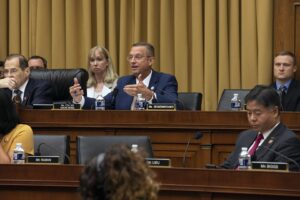
ASHEVILLE, N.C. (BP) — As more research links pornography to psychological and physiological damage, advocates hope it will soon generate the same national antipathy as smoking cigarettes.
“Pornography is the new tobacco and that’s good news,” Haley Halverson of the National Center on Sexual Exploitation said Aug. 3 during a Family Research Council policy lecture. “Pornography is pervasive and popular today — there’s no denying it and it’s a really serious problem we have to address. But so was smoking in the 1950s. It was popular, everybody did it — it was considered glamorous. But as the harms became more apparent, as the research was sent out to the public and was able to be digested by them, both the general public and elected officials demanded a public health approach to the problem.”
Halverson predicts in the same way Americans agreed tobacco was harmful, public figures and lawmakers will soon coalesce around an effort to reduce porn consumption.
In April, Utah Gov. Gary Herbert, a Republican, signed a resolution to declare pornography a public health crisis. The resolution called for new education and research initiatives to shape future policy changes aimed at reducing pornography exposure and addiction. The measure noted new technology created an environment for universal availability of pornographic material, even for children — and porn “perpetuates a sexually toxic environment.”
During the Republican National Convention in Cleveland last month, delegates unanimously adopted an amendment to the party platform to call pornography a public health crisis that is destroying lives.
“Pornography, with its harmful effects, especially on children, has become a public health crisis that is destroying the life of millions,” the amendment stated. “We encourage states to continue to fight this public menace and pledge our commitment to children’s safety and well-being.”
On Aug. 1, the Washington Examiner reported Republican presidential nominee Donald Trump signed a pledge to make enforcing existing laws against pornography a top priority of his administration. The pledge from Enough Is Enough, a non-partisan organization that aims to make the internet safer for children and families, states the president should also consider appointing a special commission to explore porn’s short- and long-term effects. Those who sign the pledge also agree to work with corporations on porn-reduction initiatives and to support other policies that shield children from porn.
Democratic presidential nominee Hillary Clinton refused to sign the pledge. Clinton said on principle she agrees with the effort but her campaign will not sign any pledges during the election season.
“This is not a partisan issue,” Halverson said. “This is an issue that everyone, whether they are concerned about the human dignity, the value of family, the impact that it has on women, can all come together and agree on this.”
In March, Time Magazine dedicated an issue to looking into the harmful side effects of porn use. Its cover story told accounts of young men growing up in a world with constant access to porn and the negative impacts it has had on their lives.
A 2014 study found evidence that excessive porn use physically shrinks the human brain. In parts of the brain controlling motivation levels and decision-making, researchers found a reduction in brain matter for heavy porn users. The discovery alarmed scientists, especially since other research shows more Americans view porn than ever before and begin at an early age, when the brain is still developing. Twenty-seven percent of millennials viewed porn before hitting puberty and nearly two-thirds of American males 24-years-old and younger actively seek out porn at least once a week, according to the study.
Barna Group research found porn use quickly desensitizes the brain’s pleasure receptors and addicts move to more hardcore and sexually violent content to satisfy urges. Of the 50 most popular pornographic videos on the internet, 88 percent contained some form of physical violence against women.
“People are exposed at such an early age that they are getting their sexual education from pornography,” she said. “This might be the first thing they learn about sex — that is sex is violent and women like it.”













